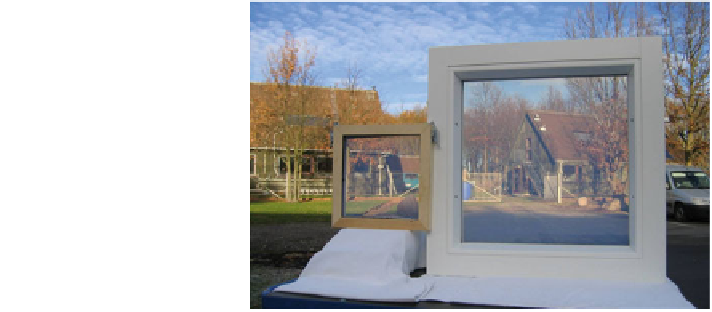Civil Engineering Reference
In-Depth Information
Fig. 12 The prototype of
super-insulating aerogel
glazing (report HILIT)
the measured value for the monolithic window prototype (15 mm aerogel) was
higher than 75 % (Jensen et al.
2004
), but, at the same time, the U-value was equal
to the best triple-layered gas-filled glazing units (U \ 0.6 W/m
2
K).
4.3 Application in Buildings
A wide number of applications of granular aerogel glazing systems in buildings were
chosen as a reliable alternative to conventional solutions especially in the USA and
in Europe: schools, libraries, commercial centres, airports, and industrial factories.
Roof applications are the most usual (Fig.
13
), because the U-values are not
dependent on the inclination to the vertical, such as in the gas-filled glazings (air,
argon, or krypton) which have a worse behaviour when used as roofs instead of
vertical panels (Fig.
14
).
The energy benefits of using granular aerogel glazing are also discussed in the
literature (Reim et al.
2002
). Referring to the German climate, the net heat flux
during 1 month (from October to April) was calculated using a simulation model
for three insulating materials (Fig.
15
):
• an aerogel glazing (U = 0.4 W/m
2
K and g = 0.3);
• a solar triple glazing (U = 0.8 W/(m
2
K) and g = 0.6); and
• an opaque insulation (U = 0.2 W/m
2
K).
• Negative values represent thermal losses and positive ones solar gains.
Results showed that granular aerogel glazing could reduce the risk of over-
heating in summer conditions on southern and east/west façades with respect to
triple glazing. On north-facing façades, the balance of aerogel glazing was
significantly better than triple glazing, due to lower U-value: the maximum heat
flux during the heating period is about -5 kWh/m
2
(a), while for the triple glazing
is -10 kWh/m
2
(a).

